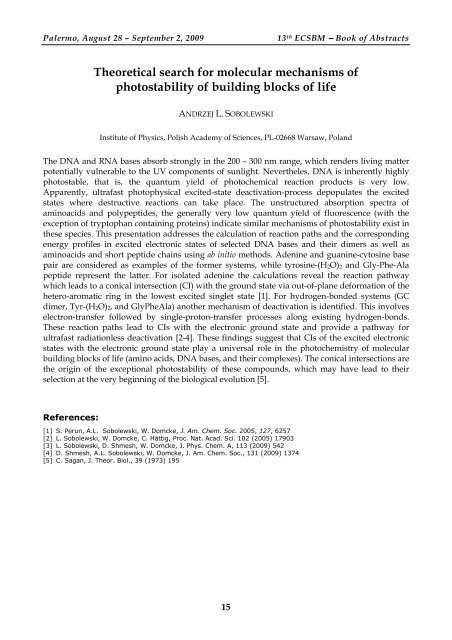XIII European Conference on the Spectroscopy of ... - ecsbm 2009
XIII European Conference on the Spectroscopy of ... - ecsbm 2009
XIII European Conference on the Spectroscopy of ... - ecsbm 2009
Create successful ePaper yourself
Turn your PDF publications into a flip-book with our unique Google optimized e-Paper software.
Palermo, August 28 – September 2, <strong>2009</strong> 13 th ECSBM −−−− Book <strong>of</strong> Abstracts<br />
Theoretical search for molecular mechanisms <strong>of</strong><br />
photostability <strong>of</strong> building blocks <strong>of</strong> life<br />
ANDRZEJ L. SOBOLEWSKI<br />
Institute <strong>of</strong> Physics, Polish Academy <strong>of</strong> Sciences, PL-02668 Warsaw, Poland<br />
The DNA and RNA bases absorb str<strong>on</strong>gly in <strong>the</strong> 200 – 300 nm range, which renders living matter<br />
potentially vulnerable to <strong>the</strong> UV comp<strong>on</strong>ents <strong>of</strong> sunlight. Never<strong>the</strong>les, DNA is inherently highly<br />
photostable, that is, <strong>the</strong> quantum yield <strong>of</strong> photochemical reacti<strong>on</strong> products is very low.<br />
Apparently, ultrafast photophysical excited-state deactivati<strong>on</strong>-process depopulates <strong>the</strong> excited<br />
states where destructive reacti<strong>on</strong>s can take place. The unstructured absorpti<strong>on</strong> spectra <strong>of</strong><br />
aminoacids and polypeptides, <strong>the</strong> generally very low quantum yield <strong>of</strong> fluorescence (with <strong>the</strong><br />
excepti<strong>on</strong> <strong>of</strong> tryptophan c<strong>on</strong>taining proteins) indicate similar mechanisms <strong>of</strong> photostability exist in<br />
<strong>the</strong>se species. This presentati<strong>on</strong> addresses <strong>the</strong> calculati<strong>on</strong> <strong>of</strong> reacti<strong>on</strong> paths and <strong>the</strong> corresp<strong>on</strong>ding<br />
energy pr<strong>of</strong>iles in excited electr<strong>on</strong>ic states <strong>of</strong> selected DNA bases and <strong>the</strong>ir dimers as well as<br />
aminoacids and short peptide chains using ab initio methods. Adenine and guanine-cytosine base<br />
pair are c<strong>on</strong>sidered as examples <strong>of</strong> <strong>the</strong> former systems, while tyrosine-(H2O)2 and Gly-Phe-Ala<br />
peptide represent <strong>the</strong> latter. For isolated adenine <strong>the</strong> calculati<strong>on</strong>s reveal <strong>the</strong> reacti<strong>on</strong> pathway<br />
which leads to a c<strong>on</strong>ical intersecti<strong>on</strong> (CI) with <strong>the</strong> ground state via out-<strong>of</strong>-plane deformati<strong>on</strong> <strong>of</strong> <strong>the</strong><br />
hetero-aromatic ring in <strong>the</strong> lowest excited singlet state [1]. For hydrogen-b<strong>on</strong>ded systems (GC<br />
dimer, Tyr-(H2O)2, and GlyPheAla) ano<strong>the</strong>r mechanism <strong>of</strong> deactivati<strong>on</strong> is identified. This involves<br />
electr<strong>on</strong>-transfer followed by single-prot<strong>on</strong>-transfer processes al<strong>on</strong>g existing hydrogen-b<strong>on</strong>ds.<br />
These reacti<strong>on</strong> paths lead to CIs with <strong>the</strong> electr<strong>on</strong>ic ground state and provide a pathway for<br />
ultrafast radiati<strong>on</strong>less deactivati<strong>on</strong> [2-4]. These findings suggest that CIs <strong>of</strong> <strong>the</strong> excited electr<strong>on</strong>ic<br />
states with <strong>the</strong> electr<strong>on</strong>ic ground state play a universal role in <strong>the</strong> photochemistry <strong>of</strong> molecular<br />
building blocks <strong>of</strong> life (amino acids, DNA bases, and <strong>the</strong>ir complexes). The c<strong>on</strong>ical intersecti<strong>on</strong>s are<br />
<strong>the</strong> origin <strong>of</strong> <strong>the</strong> excepti<strong>on</strong>al photostability <strong>of</strong> <strong>the</strong>se compounds, which may have lead to <strong>the</strong>ir<br />
selecti<strong>on</strong> at <strong>the</strong> very beginning <strong>of</strong> <strong>the</strong> biological evoluti<strong>on</strong> [5].<br />
References:<br />
[1] S. Perun, A.L. Sobolewski, W. Domcke, J. Am. Chem. Soc. 2005, 127, 6257<br />
[2] L. Sobolewski, W. Domcke, C. Hättig, Proc. Nat. Acad. Sci. 102 (2005) 17903<br />
[3] L. Sobolewski, D. Shmesh, W. Domcke, J. Phys. Chem. A, 113 (<strong>2009</strong>) 542<br />
[4] D. Shmesh, A.L. Sobolewski, W. Domcke, J. Am. Chem. Soc., 131 (<strong>2009</strong>) 1374<br />
[5] C. Sagan, J. Theor. Biol., 39 (1973) 195<br />
15


